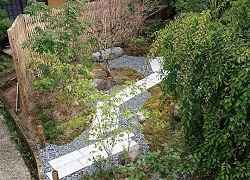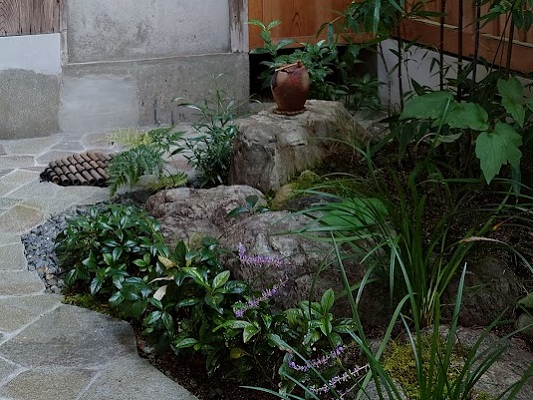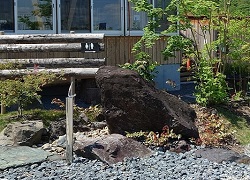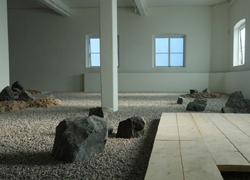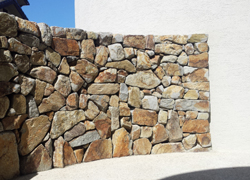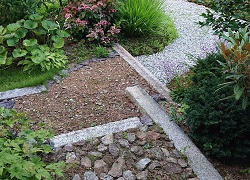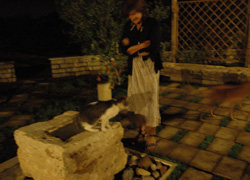
吉野山深くに位置する別荘の前庭。モダンな和の庭を、というご要望に応えるためシャープな板石敷きの園路を設け、周囲の山から集めた苔を貼った築山で変化をつけた。
Yoshino, Nara 2021. Garden for a villa situated in the deep part of the Yoshino mountain. A modern-looking Japanese garden was requested. A sharp movement of granite slab stones cuts trough the garden. The moss covering the mounds on both sides was collected from the surroundings.
老舗料理旅館の新しいダイニングルームの窓の外に作った小さな坪庭。味わいのある大振りの山石を組み、黒竹を中心に下草類であしらった。
Kawakami, Nara 2021. Tsuboniwa outside a newly built dining room of an old traditional Japanese inn. Black bamboo and various shrubs and perennials are planted in the raised bed edged by some aged, large mountain stones.
新築住宅の広い前庭に作ったアプローチ園路と駐車場。現代的なフォームと伝統的なフォームを融合させる試み。アプローチは飛鳥川のように。両岸には要所要所に飛鳥石を景石として据えた。物置周りには明日香の石造物を連想させる石の築山と石塁を設けた。
Asuka, Nara 2020. Front garden of a newly built residence, consisting of an approach path and a parking space. The approach flows like the Asuka river. Some characteristic Asuka stones on its "bank" constibute to make the scene "interesting". Additional stone works try to recall the stone heritage particular in the Asuka area.
ケーキ屋さんの店舗前の庭。長い築山に植栽(いくつかは近隣の林から移植)を施し、入口には大きな構えの手水の石組み。2棟の間の坪庭は源流の枯山水。
Ohyodo, Nara 2019. Front garden of a pastry shop/cafe. A long mound (tsukiyama) entertains a variety of trees and shrubs, some of which were transplanted from the local woods. A rock composition for hand-washing (chozu) at the entrance, and a small karesansui, recalling the deepest waterfall in the mountain, between the two buildings (pastry shop and cafe).
家の中心に位置し、台所、居間、寝室など、あらゆる方向から眺められる坪庭。そして庭の隅にはジャグジー。滝石組から大海にいたる枯山水。五葉松をアクセントに。
Göteborg, Sweden, 2017 . Courtyard garden (tsuboniwa), visible from all the rooms and corridors. Landscapes from rapid, river and down to the sea were suggested in the form of karesansui. Pinus parviflora is a strong accent to the garden.
新築住宅の前庭。巨石をはじめとする景石や飛石を据えて、奈良県中部の葛城金剛連山と吉野川の景色を共に連想させる試み。
Ohyodo, Nara, 2017 . New residential garden. Big river rocks were used to recall predominant landscapes features of this region: Katsuragi-Kongo mountains and Yoshino river.
ダンスシアターの大広間に作った枯山水のインスタレーション。この石庭を舞台にダンスと音楽の公演が催された。
Göteborg, Sweden, 2016. Karesansui installation inside the main hall of the dance theater called 3:eVaningen. Dance and music performances were held during the six-month Japan festa, using this stone garden both as meeting space and stage set.
老樹の藤に山藤のダイナミックさを表現してくれることを託して。
Seirenji, Utano, Nara 2016. The idea was to let the aged wisteria express its original dynamism as mountain wisteria.
新築住宅前庭の植栽と石の設え。 左右の小庭に分かれ、右は常緑中心の木漏れ日の庭、足元に土留めの石組。左は落葉中心で「寄せ飛石」の通路。
Kobe, 2016. Front garden of a new redidence, divided in two by the centeral entrance porch. Right side is characterized by soft soil-retaining stone composition whereas left side by path-way of tobiishi.
新築住宅のテラスを仕切る石の壁。二上山の安山岩を使用。
Kashihara, Nara, 2016. Curvilinear Stone wall to enclose the ground-floor terrace of a new residence. The andesite stones come from the nearby Nijo mountains.
お施主様保有の川石を使いアプローチ脇に小さな枯山水の石組みを。
Sakurai city, Nara, 2015. Garden for a new residence. The path, leading to the wood-deck, is paved with boulders. Large area of lawn spreads on the carefully shaped landform. From out of the window of the Japanese-style room is a weeping cherry. The karesansui was made from the collection of river stones the client owned as memento of father. Insipiration was drawn from the riverine landscape of his home village.
和室から眺める庭。延石、畑から出た礫を敷き詰めた階段、砂利敷、植込み、低い四ツ目垣で構成。
Gojo city, Nara, 2015. Garden outside the Japanese-style room, also functioning as passage to the vegetable garden outside. Composed of nobeishi edges, steps paved with "found" stones, planting beds and low bamboo fence.
モミジ、ナツハゼ、ヤマボウシ、ニシキギ、ドウダンツツジなど、紅葉と季節の移り変わりを楽しむ庭。芝と植栽の島で静かな入江のような風景を描いた。
Gojo city, Nara, 2014. The gentle curves composed of the lawn and the plant islands are drawn from an image of inlet landscape. Main plants: Acer palmatum, Enkianthus perulatus, Vaccinium oldhamii, Cornus kousa, Euonymus alatus.
レンガ敷のテラス、パーゴラ、トレリス、芝生、花壇、畑で構成される庭です。 ジューンベリー、イチゴノキ、フェイジョア、ユスラウメ、ブルーベリー、柚子、実山椒、レモン、 パーゴラに蔓バラ。トレリスにルリマツリ。玄関にシンボルツリーとしてアーモンドの木。
Otsu city, Shiga, 2014. Front garden of a residence built in Neo-classical style. The client request was a small orchard garden to enjoy flowers and fruits. The plants used were: Feijoa, Amelanchier canadensis, Arbutus unedo, Blue Berry, Myrtus communis, Lemon, Zanthoxylum piperitum, Weeping Roses over the pergola, Plumbago on the trellis. An almond tree stands as a sign of welcome and welcome-back.
松・竹(垣)・梅の吉兆の庭。枯山水、石敷園路、延石テラスで構成。回遊して、使って、見て楽しむための和風の庭。
Kashiba city, Nara, 2013. Residential garden composed of karesansui, stone-paved path, terrace paved with nobedan and essential volume of plants. The traditional auspicious trio celebrates the space: Pine, Bamboo (fence) and Prune. Collaboration with Sakamoto Zoen Doboku, Yoshino.
横に長い短冊型の庭のかたちを利用し、絵巻物のように、各部屋ごとに横に景色が展開するよう構想した。
Kashihara city, Nara, 2013. Rectangular, south-facing garden of a private residence, inspired by a series of landscape pictures dipicted across a picture scroll.
茶庭(露地)を参考に景色の展開を考え、園路や腰掛や手水鉢を配置し、
東屋の奥には枯山水にならった石組を。 その先、オリーブ畑の向こうにローマのサンピエトロ寺院の円蓋を望む。
Inspiration comes from Japanese Tea Garden and karesansui.
On the horizon beyond the olive orchard is the cupola of the St. Peters.

